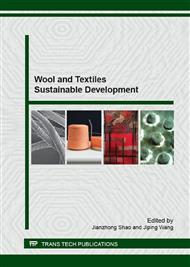[1]
Sasser, P. E., Shofner, F. M., Chu, Y. T., Shofner, C. K., & Townes, M. G. (1991). Interpretations of single fiber, bundle, and yarn tenacity data. Textile Research Journal, 61(11), 681-690.
DOI: 10.1177/004051759106101108
Google Scholar
[2]
Daniels, H. E. (1989). The maximum of a Gaussian process whose mean path has a maximum, with an application to the strength of bundles of fibres. Advances in Applied Probability, 315-333.
DOI: 10.2307/1427162
Google Scholar
[3]
Dhavan, K., Bhatt, H. H., & Radhakrishnan, T. (1984). Estimation of tensile properties of single cotton fibers from load-elongation curves of bundles. Textile research journal, 54(8), 549-551.
DOI: 10.1177/004051758405400808
Google Scholar
[4]
Frydrych, I. (1995). Relation of Single Fiber and Bundle Strengths of Cotton. Textile research journal, 65(9), 513-521.
DOI: 10.1177/004051759506500905
Google Scholar
[5]
Daniels, H. E. (1945). The statistical theory of the strength of bundles of threads. I. Proceedings of the Royal Society of London. Series A. Mathematical and Physical Sciences, 183(995), 405-435.
DOI: 10.1098/rspa.1945.0011
Google Scholar
[6]
Coleman, B. D. (1958). On the strength of classical fibres and fibre bundles. Journal of the Mechanics and Physics of Solids, 7(1), 60-70.
DOI: 10.1016/0022-5096(58)90039-5
Google Scholar
[7]
Yu W. (2000). Analysis of Wool Fiber Bundle Tensile Behavior [D]. PhD Thesis. University of New South Wales, Sydney.
Google Scholar
[8]
Pappas, Y. Z., Kontsos, A., Loutas, T. H., & Kostopoulos, V. (2004). On the characterization of continuous fibres fracture by quantifying acoustic emission and acoustic-ultrasonics waveforms. NDT & E International, 37(5), 389-401.
DOI: 10.1016/j.ndteint.2003.11.004
Google Scholar
[9]
Ellison, M. S., & Dai, J. (1996). Description and Application of an Acoustic Pulse Detector to Nylon 6 and Polypropylene Single Fiber Fracture. Textile research journal, 66(5), 295-299.
DOI: 10.1177/004051759606600502
Google Scholar
[10]
Barre, S., & Benzeggagh, M. L. (1994).
Google Scholar
[11]
Wu G, Zhong Y, Yu W. Identifying the breaks of wool fibers based on the waveform analysis of acoustic emission[J]. Textile Research Journal, 2015: 0040517514535865.
DOI: 10.1177/0040517514535865
Google Scholar
[12]
Yu, W., Chu, C. Textile Physics. 2nd edn, 72-73 (Donghua University Press., 2002).
Google Scholar


